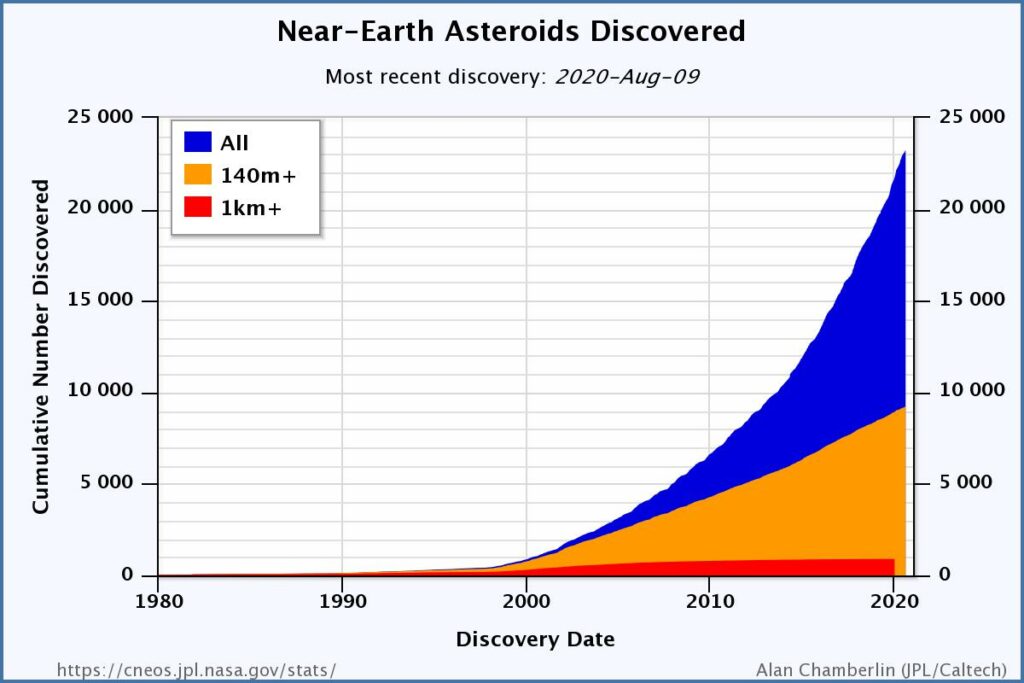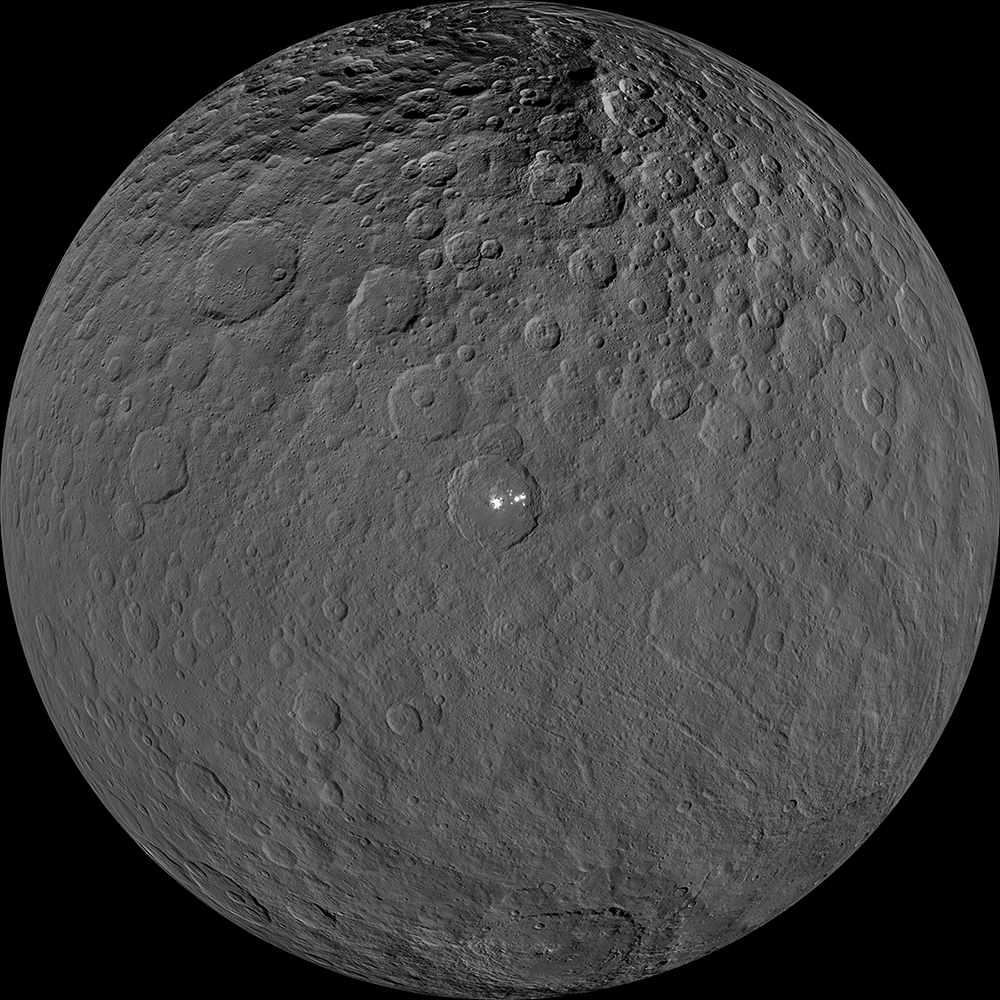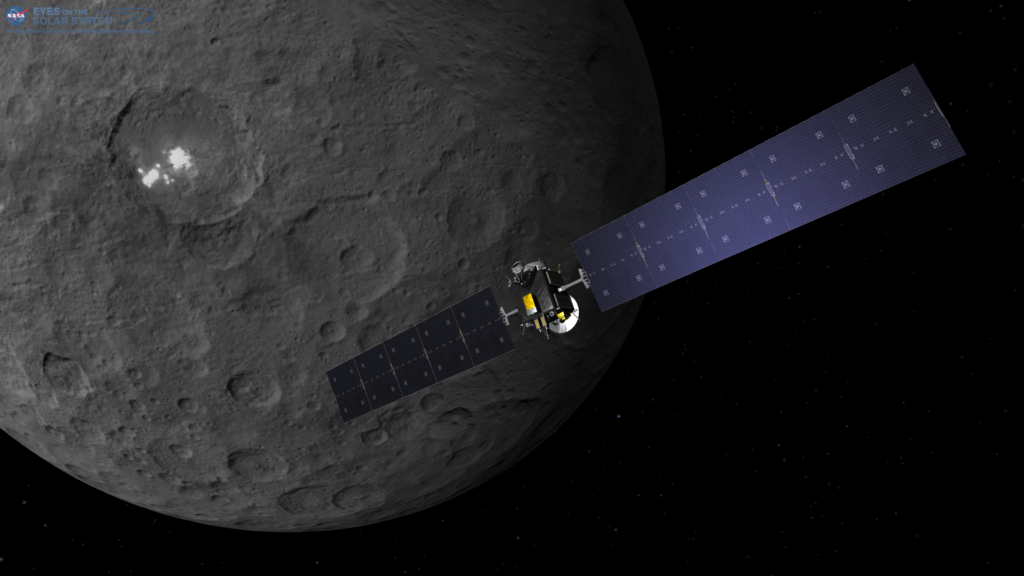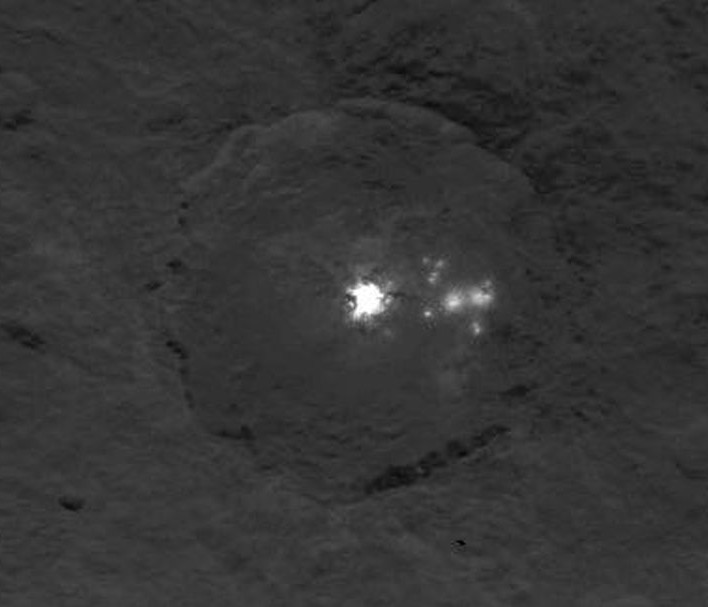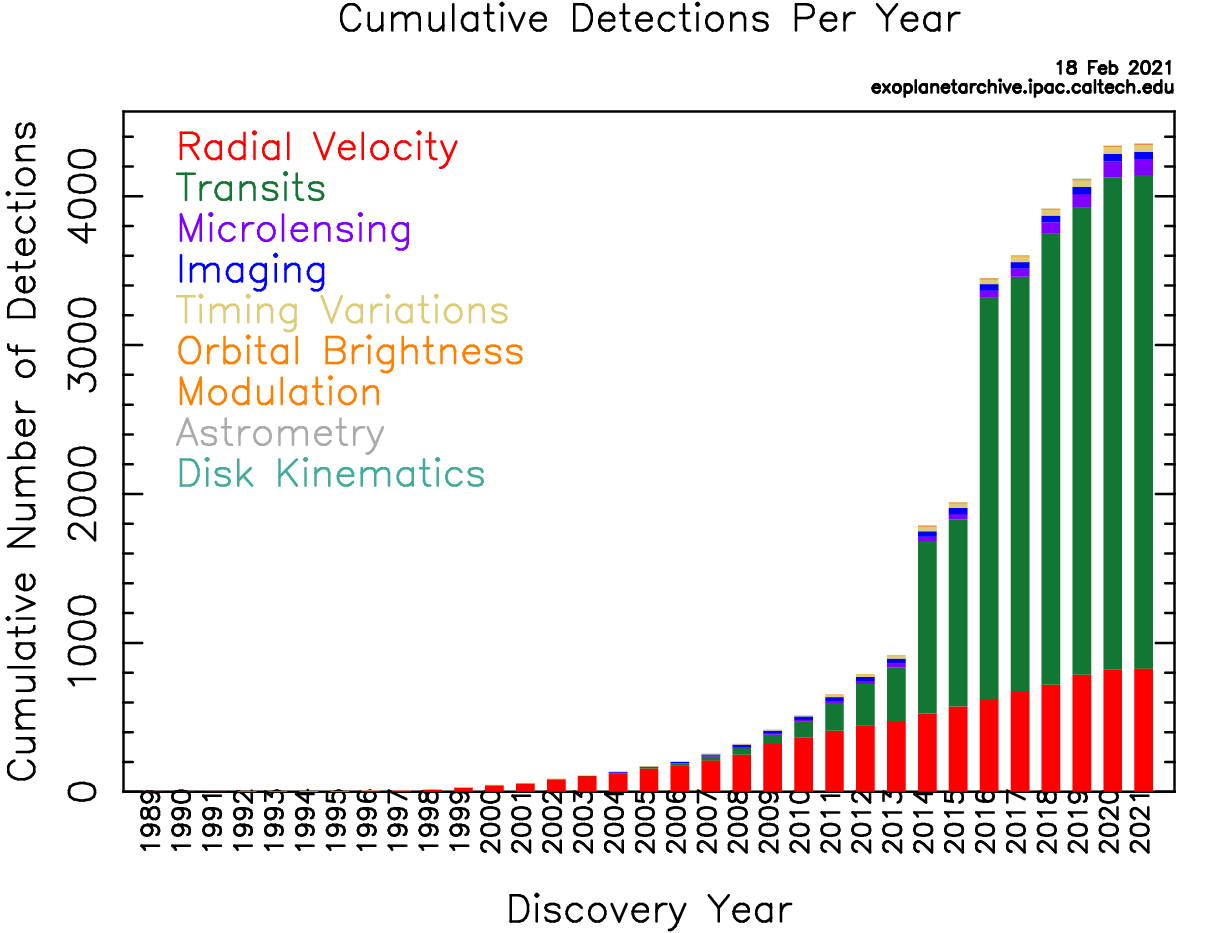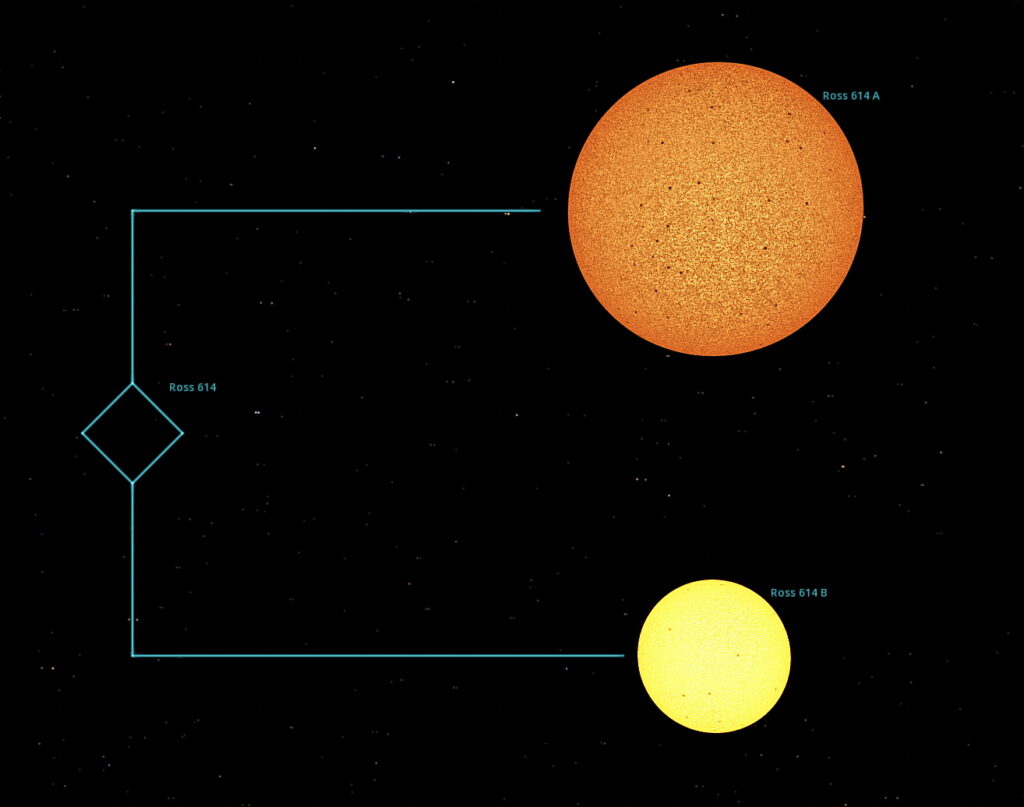Look up! The Perseid meteor shower is tonight! After midnight, look to the northeast – you may want to grab a lawn chair and a blanket. Just stare at one fixed point in the sky… and wait… Unfortunately, with the Moon being so close to the radiant, fainter meteors may be hidden from view.
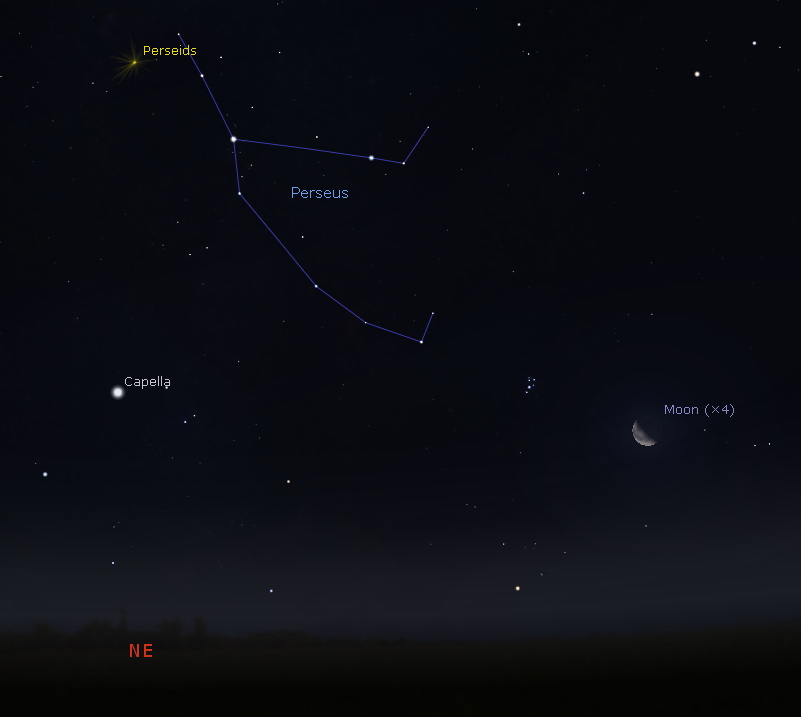 Radiant of the Perseid meteor shower in the northeastern sky after midnight on August 12th. Credit: Stellarium / Bob Trembley.
Radiant of the Perseid meteor shower in the northeastern sky after midnight on August 12th. Credit: Stellarium / Bob Trembley. Jupiter and Saturn appear in the southern sky during the early morning and predawn hours this week.
Jupiter and Saturn appear in the southern sky during the early morning and predawn hours this week.
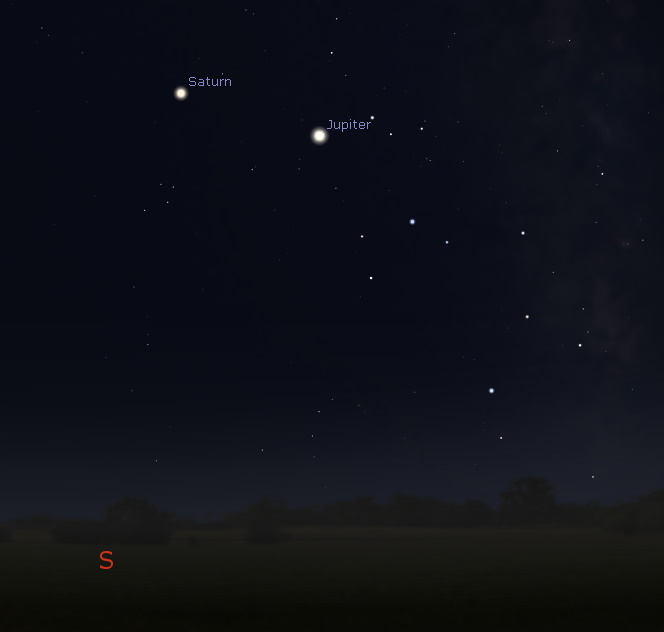 Jupiter and Saturn appear in the southern sky around midnight and move westward during the early morning hours. Credit: Stellarium / Bob Trembley.
Jupiter and Saturn appear in the southern sky around midnight and move westward during the early morning hours. Credit: Stellarium / Bob Trembley.The Moon appears with Mars in the eastern sky during the early morning hours from August 11-13th.
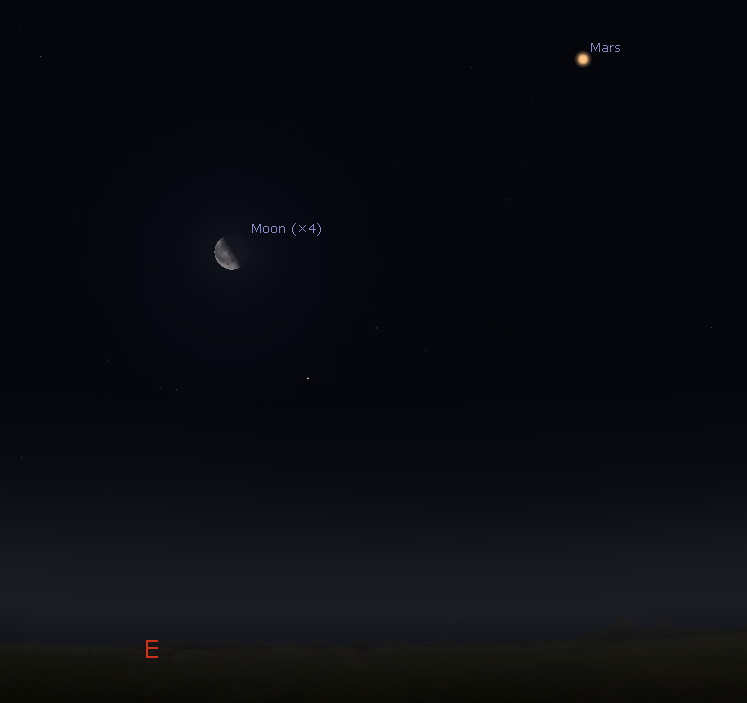 Mars appears high in the eastern sky during the early morning hours – a waning crescent Moon appears north of Mars from August 11-13th. Credit: Stellarium / Bob Trembley.
Mars appears high in the eastern sky during the early morning hours – a waning crescent Moon appears north of Mars from August 11-13th. Credit: Stellarium / Bob Trembley.The Moon appears near the star Aldebaran in the eastern predawn sky on August 13th.
The waning crescent Moon appears in conjunction with Venus and the stars Aldebaran and Betelgeuse in the eastern predawn sky on August 14th. On August 15th, the Moon appears about 3 degrees from Venus.

The third-quarter Moon occurs on Tuesday August 11th – rising around midnight, and visible to the south after sunrise.
After Tuesday, the Moon will be a waning crescent – visible low to the east before sunrise; this is one of the best times to try to spot earthshine.
 The Moon from 2020-08-11 – 2020-08-17. Visualizations by Ernie Wright / NASA’s Scientific Visualization Studio.
The Moon from 2020-08-11 – 2020-08-17. Visualizations by Ernie Wright / NASA’s Scientific Visualization Studio.Moon News
 A close-up photograph of the laser reflecting panel deployed by Apollo 14 astronauts on the Moon in 1971. Credit: NASA/JPL-Caltech.
A close-up photograph of the laser reflecting panel deployed by Apollo 14 astronauts on the Moon in 1971. Credit: NASA/JPL-Caltech.
Sunspot AR2770, which was rotating into view last week, is now in a state of decay; even at 4K resolution it appears only as a small smudge on the Sun’s face.
The coronal hole at the Sun’s north pole remains large; the coronal hole at the south pole has reopened but appears smaller than the hole to the north. Several regions of coronal loop activity appear in a line above the equator.
The Sun seen in 193 angstroms (extreme ultraviolet) August 10, 2020:
Prominences and coronal activity everywhere on the Sun’s limb over the last few days!
The Sun seen in 304 angstroms (extreme ultraviolet) August 10, 2020:
You can view the Sun in near real-time, in multiple frequencies here: SDO-The Sun Now.
You can create your own time-lapse movies of the Sun here: AIA/HMI Browse Data.
You can browse all the SDO images of the Sun from 2010 to the present here: Browse SDO archive.
Solar Activity on Facebook – Run by Solar System Ambassador Pamela Shivak
https://www.facebook.com/photo.php?fbid=10220701344157243&set=gm.3438259119518741&type=3&theater&ifg=1
Solar Corona
Solar wind speed is 300.7 km/sec (↓↓), with a density of 6.3 protons/cm3 (↓) at 1446 UT.
Near real-time animation of the corona and solar wind from the Solar & Heliospheric Observatory (SOHO):
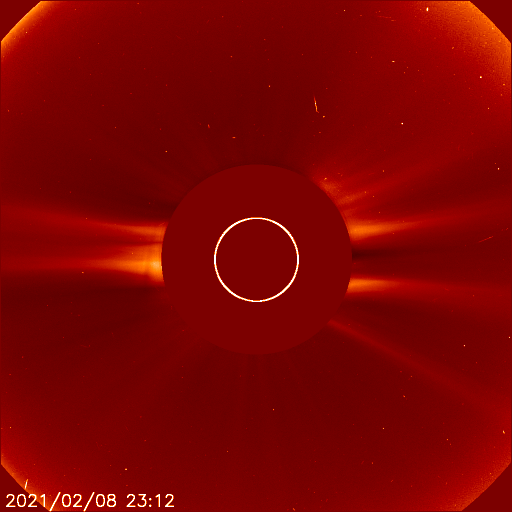 Animated LASCO C2 Coronograph showing the solar corona above the Sun’s limb (the white circle). Credit: NASA/JPL-Caltech-SOHO
Animated LASCO C2 Coronograph showing the solar corona above the Sun’s limb (the white circle). Credit: NASA/JPL-Caltech-SOHOSun News
Well…. I need to update my Sun lecture!
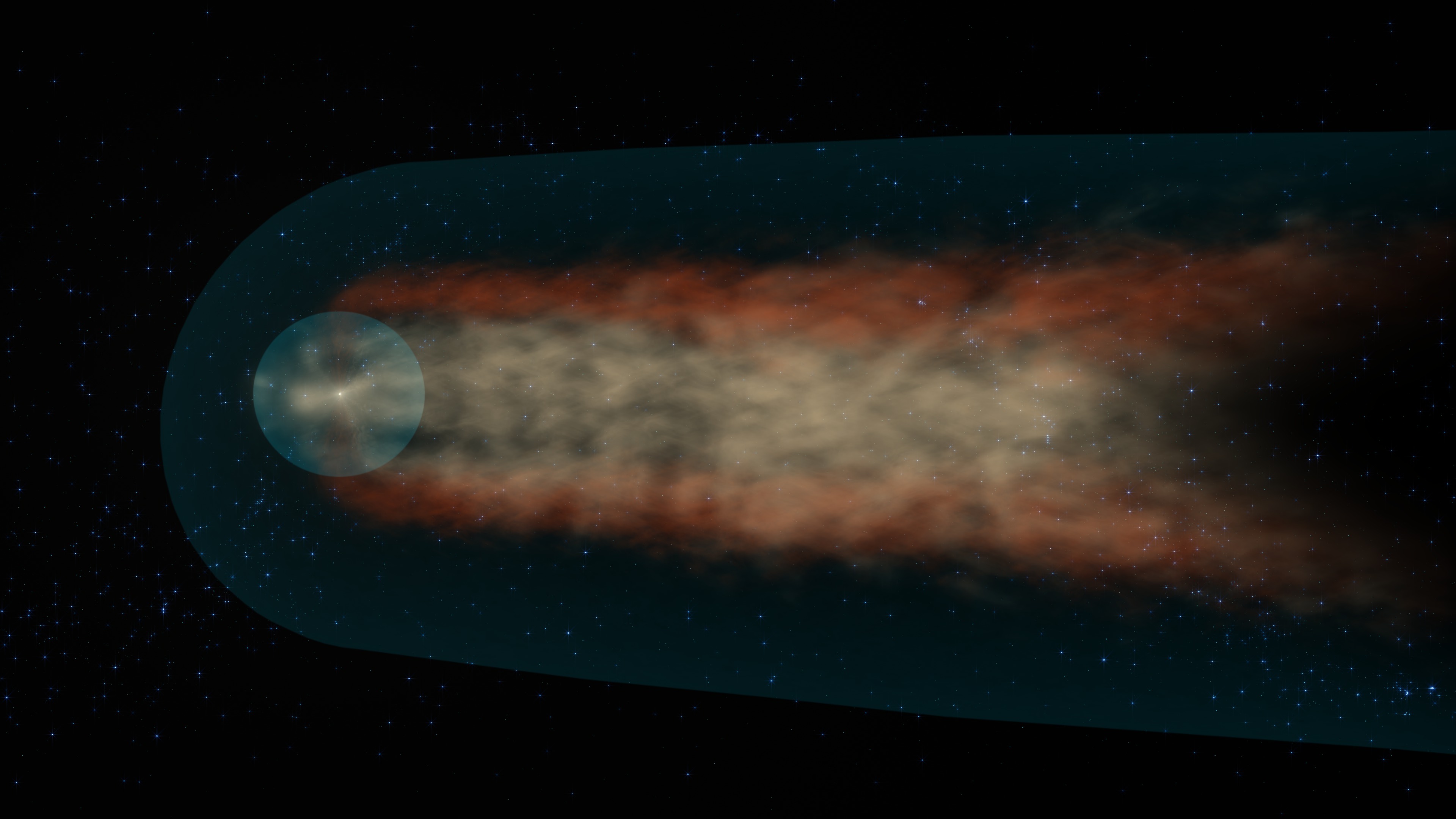 Some research suggests that the heliosphere has a long tail, much like a comet, though a new model points to a shape that lacks this long tail. Credits: NASA’s Scientific Visualization Studio/Conceptual Imaging Lab
Some research suggests that the heliosphere has a long tail, much like a comet, though a new model points to a shape that lacks this long tail. Credits: NASA’s Scientific Visualization Studio/Conceptual Imaging Lab
Potentially hazardous asteroids: 2037 (last updated June 2, 2020)
Total Minor Planets discovered: 991,765 (+1625)
Upcoming Earth-asteroid encounters::
| Asteroid |
Date(UT)
|
Miss Distance
|
Velocity (km/s)
|
Diameter (m)
|
| 2020 PC |
2020-Aug-11
|
3.1 LD
|
1.8
|
9
|
| 2020 PO |
2020-Aug-12
|
4.2 LD
|
14.5
|
22
|
| 2020 FA1 |
2020-Aug-23
|
18.4 LD
|
1.9
|
20
|
| 2016 AH164 |
2020-Aug-26
|
15.7 LD
|
5.6
|
4
|
| 2011 ES4 |
2020-Sep-01
|
0.3 LD
|
8.2
|
30
|
| 465824 |
2020-Sep-06
|
19.4 LD
|
14
|
162
|
| 2012 RM15 |
2020-Sep-12
|
14.9 LD
|
9.8
|
45
|
| 2017 US |
2020-Sep-13
|
17.3 LD
|
5.9
|
21
|
| 2014 QJ33 |
2020-Sep-18
|
11.5 LD
|
8.3
|
65
|
| 2017 SL16 |
2020-Sep-20
|
8.9 LD
|
6.4
|
25
|
| 2001 GP2 |
2020-Oct-01
|
6.1 LD
|
2.2
|
15
|
| 2010 UC |
2020-Oct-04
|
14.6 LD
|
3.2
|
12
|
| 2019 SB6 |
2020-Oct-07
|
11.9 LD
|
7.6
|
16
|
Notes: LD means “Lunar Distance.” 1 LD = 384,401 km, the distance between Earth and the Moon. Red highlighted entries are asteroids that either pass very close, or very large with high relative velocities to the Earth. Table from SpaceWeather.com
 On August 10, 2020, the NASA All Sky Fireball Network reported 53 fireballs.
On August 10, 2020, the NASA All Sky Fireball Network reported 53 fireballs.
(30 Perseids, 23 sporadics)
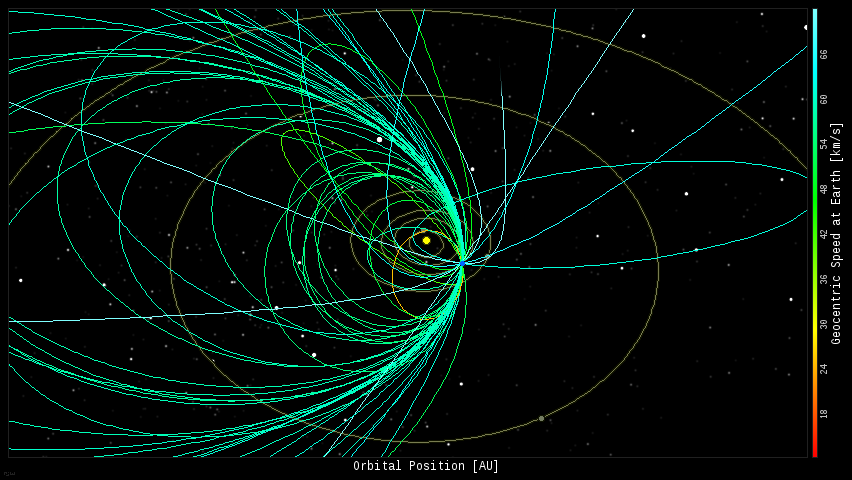 In this diagram of the inner solar system, all of the fireball orbits intersect at a single point–Earth. The orbits are color-coded by velocity, from slow (red) to fast (blue). Credit: SpaceWeather.com
In this diagram of the inner solar system, all of the fireball orbits intersect at a single point–Earth. The orbits are color-coded by velocity, from slow (red) to fast (blue). Credit: SpaceWeather.comFireball News: Perseids Meteor Shower Tonight!
 Position of the planets and a couple spacecraft in the inner solar system.
Position of the planets and a couple spacecraft in the inner solar system.
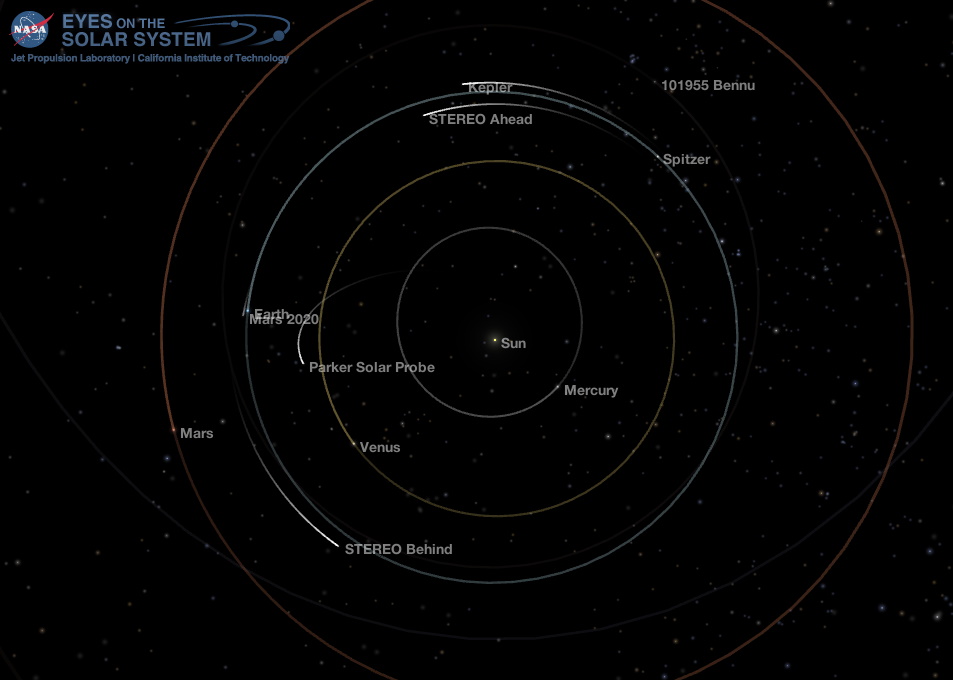 Position of the planets and a couple spacecraft in the inner solar system, 2020-08-11. Credit: NASA Eyes on the Solar System / Bob Trembley.
Position of the planets and a couple spacecraft in the inner solar system, 2020-08-11. Credit: NASA Eyes on the Solar System / Bob Trembley.Position of the planets in the middle solar system:
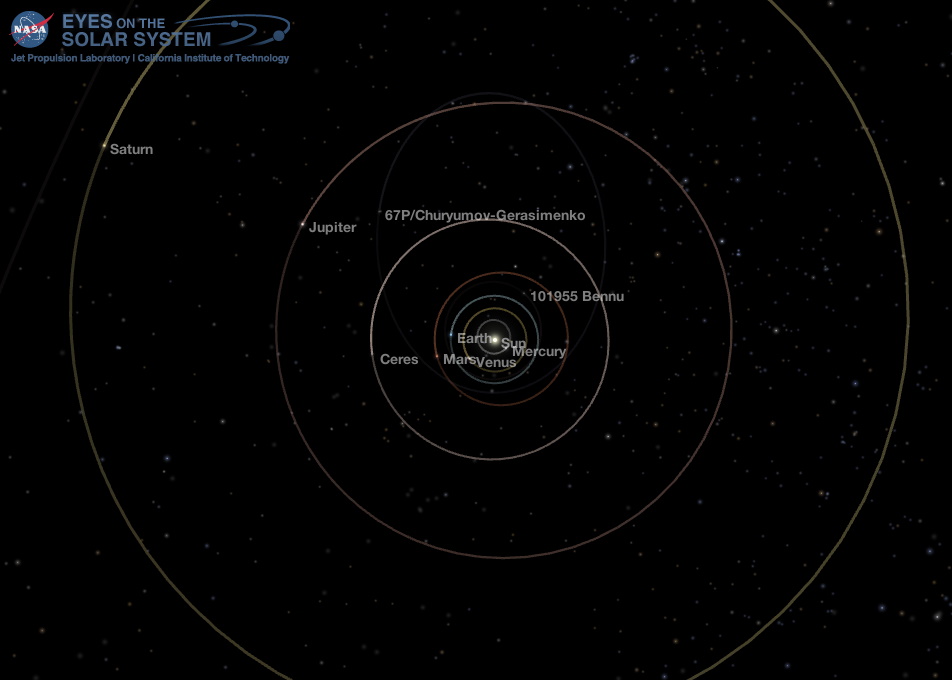 Position of the planets in the middle solar system, 2020-08-11. Credit: NASA Eyes on the Solar System / Bob Trembley.
Position of the planets in the middle solar system, 2020-08-11. Credit: NASA Eyes on the Solar System / Bob Trembley.Position of the planets, some dwarf planets and some transneptunian objects in the outer solar system:
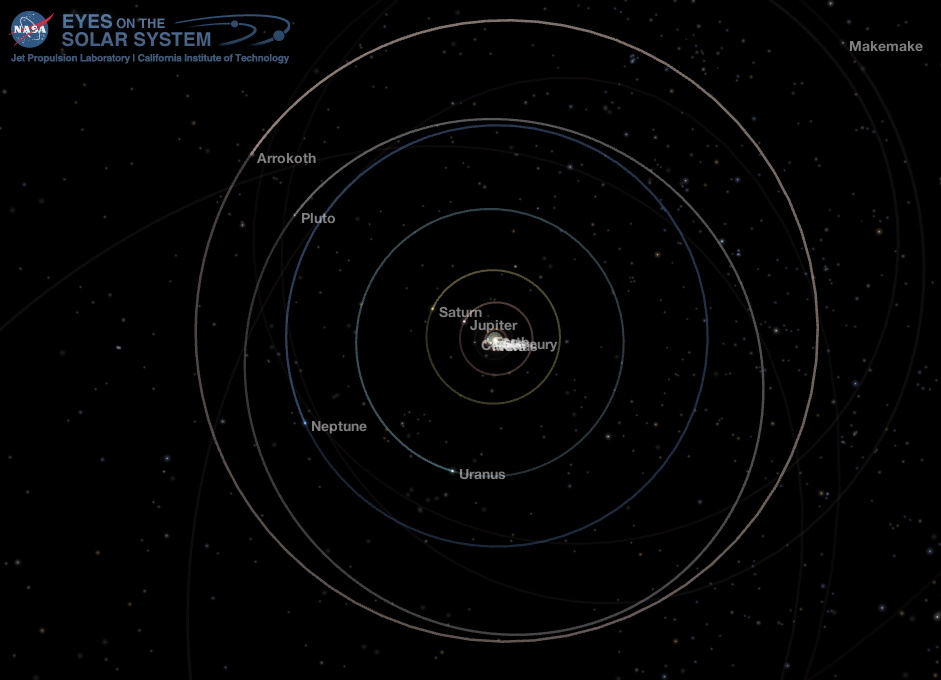 Position of the planets and some transneptunian objects in the outer solar system, 2020-08-11. Credit: NASA Eyes on the Solar System / Bob Trembley.
Position of the planets and some transneptunian objects in the outer solar system, 2020-08-11. Credit: NASA Eyes on the Solar System / Bob Trembley.
Highlight: Ceres
Ceres (/ˈsɪəriːz/; minor-planet designation: 1 Ceres) is the largest object in the main asteroid belt that lies between the orbits of Mars and Jupiter. With a diameter of 940 km (580 mi), Ceres is both the largest of the asteroids and the only dwarf planet inside Neptune’s orbit. It is the 25th-largest body in the Solar System within the orbit of Neptune.
Ceres was the first asteroid to be discovered (by Giuseppe Piazzi at Palermo Astronomical Observatory on 1 January 1801). It was originally considered a planet, but was reclassified as an asteroid in the 1850s after many other objects in similar orbits were discovered.
Ceres is the only object in the asteroid belt rounded by its own gravity, although Vesta and perhaps other asteroids were so in the past. From Earth, the apparent magnitude of Ceres ranges from 6.7 to 9.3, peaking once at opposition every 15 to 16 months, which is its synodic period. Thus even at its brightest, it is too dim to be seen by the naked eye, except under extremely dark skies. Ceres has been classified as a C-type asteroid and, due to the presence of clay minerals, as a G-type asteroid.
Ceres appears to be partially differentiated into a muddy (ice-rock) mantle/core and a less-dense but stronger crust that is at most 30 percent ice. It probably no longer has an internal ocean of liquid water, but there is brine that can flow through the outer mantle and reach the surface. The surface is a mixture of water ice and various hydrated minerals such as carbonates and clay. Cryovolcanoes such as Ahuna Mons form at the rate of about one every fifty million years. In January 2014, emissions of water vapor were detected from several regions of Ceres. This was unexpected because large bodies in the asteroid belt typically do not emit vapor, a hallmark of comets. The atmosphere, however, is transient and of the minimal kind known as an exosphere.
The robotic NASA spacecraft Dawn entered orbit around Ceres on 6 March 2015. – Wikipedia
There is an lot more about Ceres in this Wikipedia article.
Read more about Ceres on NASA’s Solar System Exploration site: https://solarsystem.nasa.gov/planets/dwarf-planets/ceres/overview/

NASA’s OSIRIS-REx Asteroid Sample Return Mission
International Space Station
NASA Perseverance Mars Rover
Climate

ex·o·plan·et /ˈeksōˌplanət/, noun: a planet orbiting a star other than the Sun.
Data from the NASA Exoplanet Archive
* Confirmed Planets Discovered by TESS refers to the number planets that have been published in the refereed astronomical literature.
* TESS Project Candidates refers to the total number of transit-like events that appear to be astrophysical in origin, including false positives as identified by the TESS Project.
* TESS Project Candidates Yet To Be Confirmed refers to the number of TESS Project Candidates that have not yet been dispositioned as a Confirmed Planet or False Positive.

Hubble: Beautiful Universe
The Local Stellar Neighborhood
Continuing with my visual tour of nearby stars and their systems, we travel to the Ross 614 system, 13.3 light years distant.
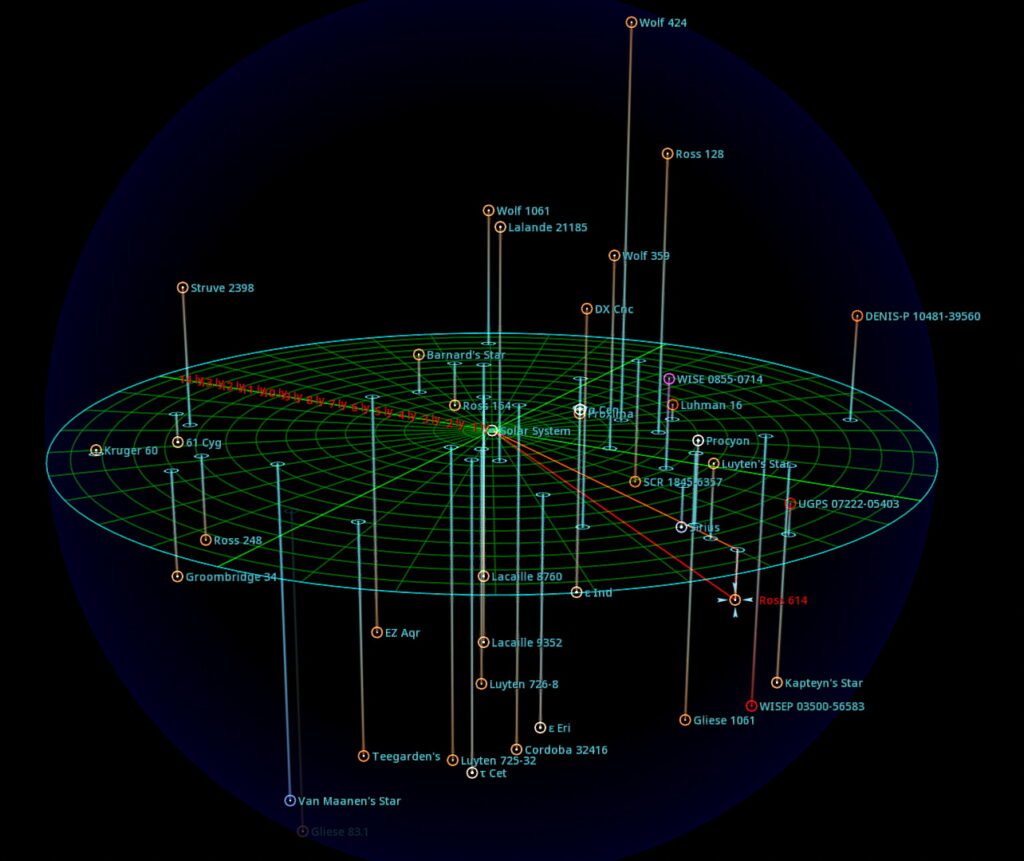 Ross 614 is about 13.3 light years from Sol; the plane (green) is aligned with the orientation of the plane of the Milky Way galaxy. Credit: SpaceEngine / Bob Trembley.
Ross 614 is about 13.3 light years from Sol; the plane (green) is aligned with the orientation of the plane of the Milky Way galaxy. Credit: SpaceEngine / Bob Trembley.Ross 614
Ross 614 (V577 Monocerotis) is a red dwarf UV Ceti flare star and it is the primary member of a nearby binary star system in the constellation of Monoceros. This star has a magnitude of about 11, making it invisible to the unaided eye even though it is one of the stars nearest to the Sun. This system is among the closest to the Sun at an estimated distance of about 13.3 light years. Because this star is so close to the Earth it is often the subject of study, hence the large number of designations by which it is known.
Binary Star System
This binary star system consists of two closely spaced low-mass red dwarfs. The secondary star is a dim magnitude 14 lost in the glare of the nearby primary star. The most recent determination of the system orbital elements comes from a study by George Gatewood using older sources along with data from the Hipparcos satellite. This study yielded an orbital period of about 16.6 years and a semi-major axis separation of about 1.1 arc seconds (2.4–5.3 AU).
History
The primary star was discovered in 1927 by F. E. Ross using the 40 in (100 cm) refractor telescope at the Yerkes Observatory. He noticed the high proper motion of this dim 11th magnitude star in his second-epoch plates that were part of an astronomical survey started by E. E. Barnard, his predecessor at the observatory. Ross then included this new star in his eponymous catalog along with many others he discovered.
The first detection of a binary system was in 1936 by Dirk Reuyl using the 26-in refractor telescope of the McCormick Observatory at the University of Virginia using astrometric analysis of photographic plates. In 1951 Sarah L. Lippincott made the first reasonably accurate predictions of the position of the secondary star using the 24 in (61 cm) refractor telescope of the Sproul Observatory. These calculations were used by Walter Baade to find and optically resolve this binary system for the first time using the then new 5 m (200 in) Hale Telescope at the Palomar Observatory in California. – Wikipedia
Ross 614 System Diagram
Ross 614 System Orbital Diagram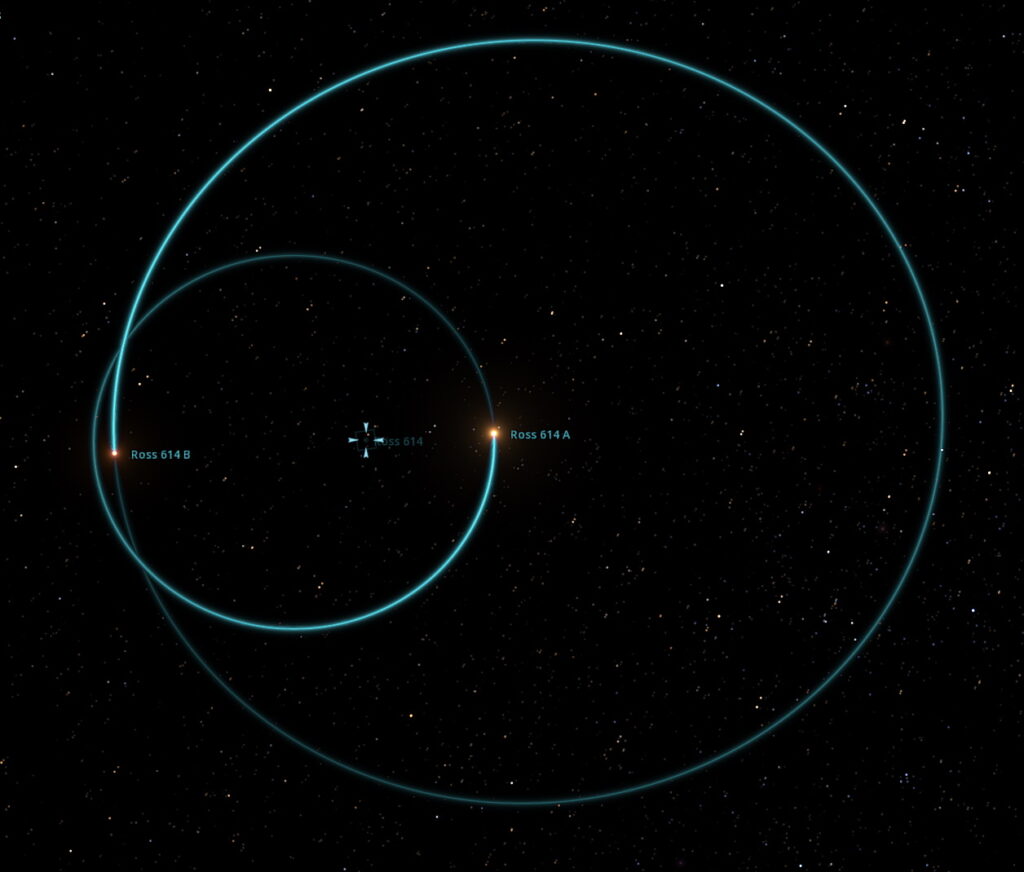
Artist’s Rendering of the Ross 614 system
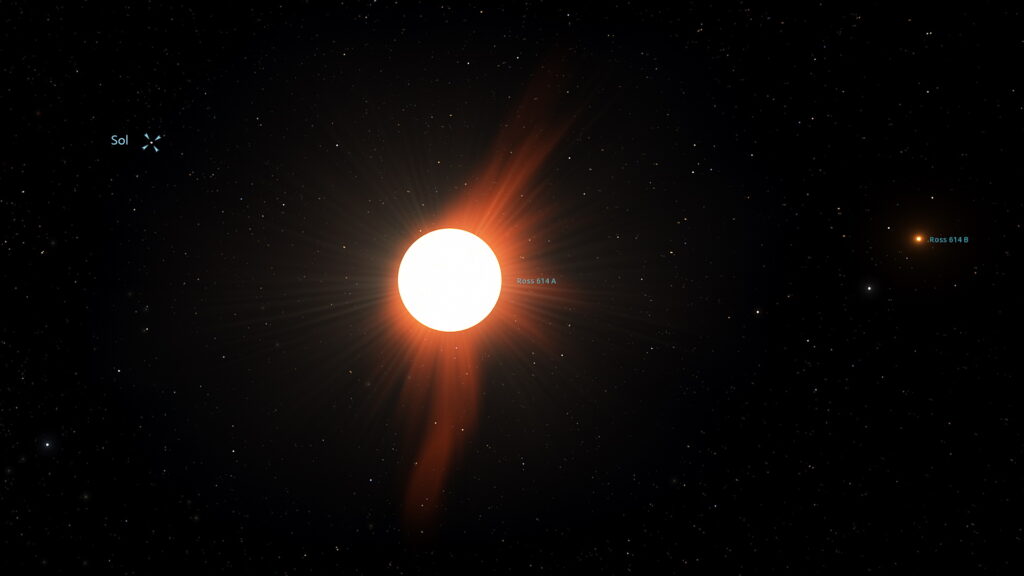 Artistic rendering of the Ross 614 binary system – the position of Sol is highlighted in the upper right.. Credit: SpaceEngine / Bob Trembley.
Artistic rendering of the Ross 614 binary system – the position of Sol is highlighted in the upper right.. Credit: SpaceEngine / Bob Trembley.Stay safe, be well, and look up!
Apps used for this post:
NASA Eyes on the Solar System: an immersive 3D solar system and space mission simulator – free for the PC /MAC. I maintain the unofficial NASA Eyes Facebook page.
Universe Sandbox: a space simulator that merges real-time gravity, climate, collision, and material interactions to reveal the beauty of our universe and the fragility of our planet. Includes VR support.
SpaceEngine: a free 3D Universe Simulator for Windows. Steam version with VR support available.
Stellarium: a free open source planetarium app for PC/MAC/Linux. It’s a great tool for planning observing sessions. A web-based version of Stellarium is also available.
NOTE: Stellarium version 0.20.2 has been released! Get it free here: http://stellarium.org/en/
Section header image credits:
The Sky – Stellarium / Bob Trembley
Observing Target – Turn Left at Orion / M. Skirvin
The Moon – NASA/JPL-Caltech
The Sun – NASA/JPL-Caltech
Asteroids – NASA/JPL-Caltech
Fireballs – Credited to YouTube
Comets – Comet P/Halley, March 8, 1986, W. Liller
The Solar System – NASA Eyes on the Solar System / Bob Trembley
Spacecraft News – NASA Eyes on the Solar System / Bob Trembley
Exoplanets – Space Engine / Bob Trembley
Light Pollution – NASA’s Black Marble
The Universe – Universe Today
